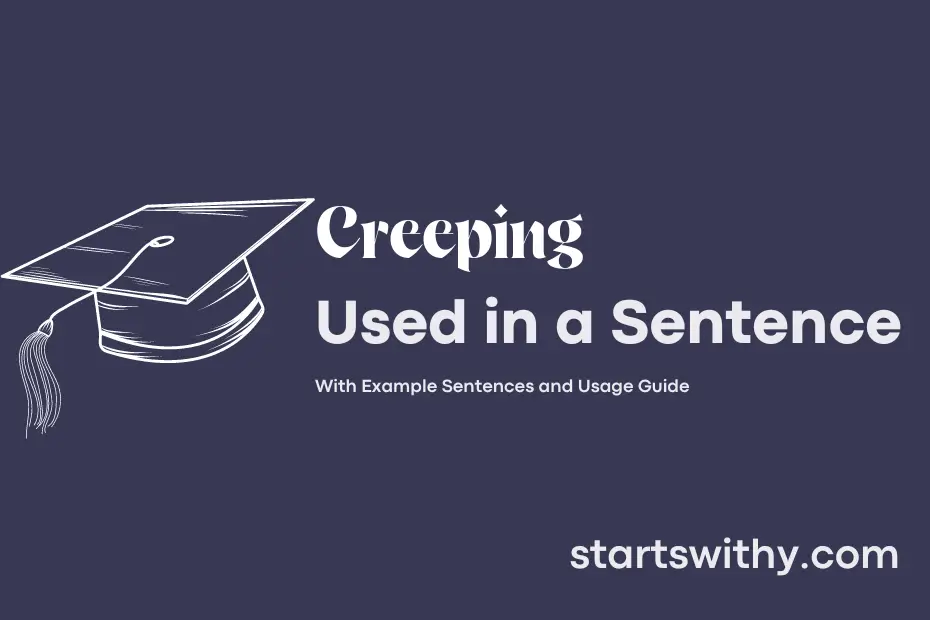Have you ever wondered what “creeping” means in a sentence? “Creeping” is used to describe something that moves slowly and gradually, often in a way that may seem sneaky or stealthy.
In language, a sentence with “creeping” can depict a variety of scenarios, from describing a plant slowly spreading its vines to portraying a person’s behavior as subtly making its way into a situation. Let’s explore the different ways this word can be employed in writing to add depth and detail to your descriptions.
7 Examples Of Creeping Used In a Sentence For Kids
- The creeping cat quietly approached the mouse.
- Creeping vines wrapped around the tree trunk.
- The creeping spider crawled up the wall.
- The creeping fog covered the field.
- The creeping shadows grew longer as the sun set.
- The creeping turtle slowly made its way to the pond.
- Creeping roots spread out beneath the ground.
14 Sentences with Creeping Examples
- Creeping deadlines for assignments can cause unnecessary stress for college students.
- It’s important to stay organized to prevent creeping chaos in your academic schedule.
- Procrastination often leads to creeping anxiety about upcoming exams.
- Creeping doubts about one’s abilities can hinder academic performance.
- Late-night study sessions can result in creeping exhaustion the next day.
- It’s essential to keep track of expenses to avoid creeping financial problems.
- Missing classes can lead to creeping gaps in your understanding of the subject.
- Social media distractions can cause creeping delays in completing assignments.
- Creeping distractions in the form of notifications can disrupt your focus during lectures.
- Lack of regular exercise can lead to creeping health issues in college students.
- Creeping comparison with peers can affect your self-confidence and mental well-being.
- It’s important to address creeping feelings of loneliness by connecting with friends or seeking support from the college counseling center.
- Proactively managing stress can prevent creeping burnout during the semester.
- Creeping self-doubt can be overcome by seeking feedback from professors and peers.
How To Use Creeping in Sentences?
To use the word Creeping in a sentence, you can follow these simple steps:
-
Understand the meaning: Creeping can mean moving slowly and quietly to avoid being noticed, or spreading gradually into a new area. Make sure you know the context in which you want to use the word.
-
Choose your context: Decide whether you want to use Creeping to describe something moving slowly and stealthily, or something spreading gradually.
-
Construct your sentence: When you have your context in mind, start constructing your sentence. For example:
- “The cat was creeping towards the bird feeder, trying not to make a sound.”
- “I could see the vines creeping up the side of the building, slowly taking over.”
-
Check for appropriateness: Make sure that the use of Creeping fits well within the context of your sentence and conveys the meaning you intended.
-
Practice using it: To get more comfortable with using the word, try using it in different sentences and contexts. This will help you become more familiar with how to incorporate Creeping effectively in your writing or conversation.
By following these steps, you can effectively incorporate the word Creeping into your vocabulary and communication. Enjoy experimenting with this word and have fun expanding your linguistic skills!
Conclusion
In conclusion, sentences with “creeping” illustrate a gradual or subtle movement or progression. This word is frequently used to describe something slowly advancing or spreading, suggesting a sense of stealthiness or gradual encroachment. Examples like “The vine was creeping across the fence” or “A feeling of unease began creeping up on him” paint a vivid picture of this gradual, almost imperceptible action.
Overall, sentences with “creeping” effectively convey a sense of gradual progression or movement, adding depth and nuance to descriptions. Whether it’s a physical object like a vine or an abstract concept like fear, using this word can lend a sense of unease or stealth to the narrative, making it a valuable addition to the writer’s toolkit for creating vivid and evocative imagery.



